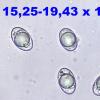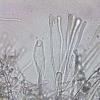
03-12-2017 11:53
François BartholomeeusenIn the middle of an alder swamp forest, in Belgium

02-12-2017 11:41
Thorben HülsewigHi there,a few days ago i found this fungus next t

30-11-2017 23:31
Garcia SusanaPeritecios en torno a 300-400 um de diámetro con

01-12-2017 11:35
José Antonio López-SáezWould you be so kind to help me identify the follo

01-12-2017 07:36
 Nicolas VAN VOOREN
Nicolas VAN VOOREN
Bonjour.Un nouveau numéro des Cahiers de la FMBDS

29-11-2017 22:39
F. JAVIER BALDA JAUREGUIuna idea ,para este anamorfo que crecia sobre Pyth
In the middle of an alder swamp forest, in Belgium, is a dike that the last six months has been inundated by the high water level.
Ascomata was found in November, at the base of a mossy, dead poplar (populus) seemingly growing on the bark.
Apothecium: 14 x 15 mm, saddle-shaped, selliform, grey-green, the brim is not attached to the stipe except one attachment of 0.5 mm wide;
Stalk: dirty yellow, 27 mm long, at the top 6 mm and 4 mm wide at the base, the whole length ribbed, the ribs run 2 mm further on the apothecium;
Spores: elliptical, 15,23-19,43 x 10,36-12,97 µm, Q = 1.53, 1 large drop and several small ones,
Asci: 194,53-261,53 x 16.77-22,17 µm; cylindrical, IKI-;
Paraphyse: septated, filiform, branched and 5 µm wide with up to 8 µm swollen top
Ectal exipulum: textura globulosa-subglobulosa length > 50 µm
Medular exipulum: textura intricate
Could this be Hevella lacunose var. sulcata or is it a H. lacunose that suffered from the wet weather and environmental conditions? Thanks for your help!
Greetings,
François Bartholomeeusen
Thanks for your good suggestion. I have read the description of H. phlebophora in Ascomycete.org and in Coolia 27 (1) but I still have my doubts. The ribs of the stalk continue on the bottom of the cap but they become very soon furrowed. My spore sizes are also slightly larger.
Greetings,
François






